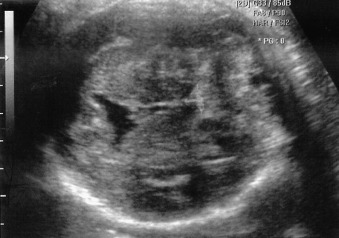Abstract
Septooptic dysplasia (SOD) is a rare heterogeneous disorder characterized by optic nerve hypoplasia, midline forebrain abnormalities such as agenesis of the corpus callosum and absence of the cavum septi pellucidi, and pituitary hypoplasia with consequent panhypopituitarism. Diagnosis of SOD requires the presence of any two of the classic features: optic nerve hypoplasia, midline forebrain abnormalities, or pituitary hypoplasia. The etiology of SOD is uncertain but may be the result of mutations in the homeobox gene HESX1 or a possible autosomal recessive inheritance. Sporadic cases are thought to be the result of vascular disruption, exposure to teratogens such as valproic acid and ethanol, viral infections such as cytomegalovirus, or maternal drug abuse with cocaine and amphetamines. Clinical manifestation is variable and depends on the extent of the anatomic defects and the degree of pituitary involvement. Most affected individuals exhibit neurodevelopmental disability, visual deficits, and seizures. The classic ultrasound finding is absence of the cavum septi pellucidi, with communication between the two frontal horns across the midline. The corpus callosum may be present, thinned, or absent. Mild ventriculomegaly is commonly seen. No special obstetric management is required for patients carrying a fetus with suspected SOD. Genetic amniocentesis may be helpful to rule out aneuploidy and to facilitate parental counseling. Termination of pregnancy is an option when the diagnosis is certain and made early. Neonatology or pediatric neurology consultation is beneficial to prepare parents regarding follow-up in the neonatal period and long-term prognosis.
Keywords
absent cavum septi pellucidi, agenesis of the corpus callosum, midline forebrain abnormalities, optic nerve hypoplasia, pituitary hypoplasia, ventriculomegaly
Introduction
Septooptic dysplasia (SOD), also known as de Morsier syndrome, is a rare heterogeneous disorder. It is characterized by optic nerve hypoplasia and midline forebrain abnormalities, such as agenesis of the corpus callosum, absence of the cavum septi pellucidi, and pituitary hypoplasia with consequent panhypopituitarism. It has been proposed that the terms SOD and de Morsier syndrome should be abandoned, as they are not independent entities.
Disease
Definition
Diagnosis of SOD requires the presence of any two of the classic features: (1) optic nerve hypoplasia, (2) midline forebrain abnormalities, or (3) pituitary hypoplasia.
Prevalence and Epidemiology
The reported incidence is 1 : 10,000 live births, equally prevalent in males and females. Some studies suggest SOD is more common in younger mothers and primigravidas. It has also been shown to occur more frequently in areas with high population density, inner-city areas with high rates of unemployment, and areas with high rates of teenage pregnancy.
Etiology and Pathophysiology
The etiology of SOD is uncertain. It may be the result of mutations in the homeobox gene HESX1, or a possible autosomal recessive inheritance. Sporadic cases are thought to be the result of vascular disruption, exposure to teratogens such as valproic acid and ethanol, viral infections such as cytomegalovirus, or maternal drug abuse with cocaine and amphetamines.
Manifestations of Disease
Clinical Presentation
Clinical manifestation of SOD is variable and depends on the extent of the anatomic defects and the degree of pituitary involvement. Most affected individuals exhibit neurodevelopmental disability, visual deficits, and seizures. Associated eye abnormalities include nystagmus, microphthalmia, and colobomas of the iris, choroids, and retina. Associated cranial anomalies include ventriculomegaly, agenesis of the corpus callosum, and schizencephaly. Craniofacial anomalies include bilateral cleft lip/palate, high arched palate, and flat nasal bridge. Mental retardation is common.
Signs of anterior and posterior pituitary deficiency are present in approximately 45% to 60% of affected individuals. Low levels of growth hormone and antidiuretic hormone may result in pituitary dwarfism and diabetes insipidus. Pubertal delay or precocious puberty may also occur. Another endocrine manifestation is secondary hypothyroidism, a condition characterized by low levels of thyroid hormones, with concomitant low levels of thyroid-stimulating hormone.
Imaging Technique and Findings
Ultrasound.
The classic ultrasound (US) finding is absence of the cavum septi pellucidi, with communication between the two frontal horns across the midline. This gives a typical “squared roof” appearance ( Fig. 35.1 ). The corpus callosum may be present, thinned, or absent. Mild ventriculomegaly is commonly seen.











